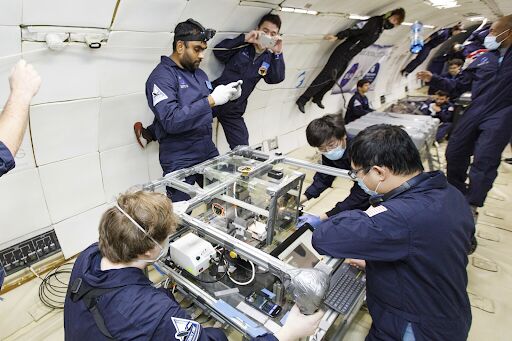Iowa State researchers take to zero gravity

The NINJAS team tests their 3D printing process during a zero-gravity test flight.
March 3, 2022
The Iowa State NINJAS team tested their novel 3D printing process in zero gravity.
The NINJAS team, an acronym for No-Gravity Ink Jet Printing for Aeronautics and Space, is a research team from the College of Engineering who have developed a new method for 3D printing that works in zero-gravity environments.
The team developed their process at ISU’s Flexible Electronics and Additive Printing Laboratory located in the Black Engineering Building on campus. The idea came in response to needs presented by long-term space exploration, especially missions done by NASA, which has partnered with the NINJAS team.
“For future NASA missions, space exploration missions, they want to not only send people there and back but also facilities for the long term,” said Hantang Qin, an assistant professor in industrial and manufacturing systems engineering and the team’s principal investigator. “That’s what we’re trying to do. We are building the printer, so the printer can stay on the International Space Station or on Mars for a long time.”
Divided into two different teams, one group worked on creating the printer, and the other developed new inks made with silver and barium titanate (patent pending). A traditional 3D printer relies on gravity for the ink to set into place, but that is not an option in a zero-gravity environment. Instead, the team developed a printer that used electrical force instead of gravity to set the ink.
In December, the printer and the inks were tested over three days on test flights at Fort Lauderdale International Airport, Zero Gravity Corporation’s research facility, in Fort Lauderdale, Fla.
“[The] first day gave us really precious experience,” said Shan Jiang, an assistant professor in materials science and engineering and one of the team’s co-principal investigators. “We realized a few things we didn’t do 100 percent. It went really well the second and third day. We printed out some nice patterns. It was the first time we proved that our 3D technology and nano ink can be used in a zero-g environment.”
A major obstacle that the team had to overcome while testing was motion sickness from the zero-gravity environment.
“It’s a lot like jumping from a building that’s 30,000 feet high for 20-30 seconds,” said Qin. “It was tough.”
“It’s almost one of the most difficult experiments I’ve done in my life,” said Jiang. “People got motion sick.”
Moving forward, the team will continue to test their 3D printing process and materials while working with NASA. More zero-gravity test flights will take place in May.






